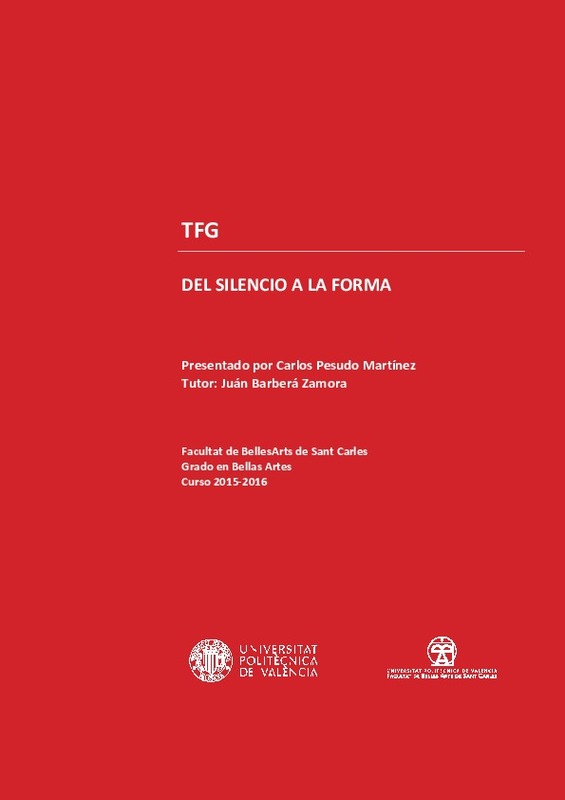JavaScript is disabled for your browser. Some features of this site may not work without it.
Buscar en RiuNet
Listar
Mi cuenta
Estadísticas
Ayuda RiuNet
Admin. UPV
DEL SILENCIO A LA FORMA
Mostrar el registro sencillo del ítem
Ficheros en el ítem
| dc.contributor.advisor | Barberá Zamora, Juan José
|
es_ES |
| dc.contributor.author | Pesudo Martínez, Carlos
|
es_ES |
| dc.date.accessioned | 2016-11-14T11:06:39Z | |
| dc.date.available | 2016-11-14T11:06:39Z | |
| dc.date.created | 2016-07-14 | |
| dc.date.issued | 2016-11-14 | es_ES |
| dc.identifier.uri | http://hdl.handle.net/10251/73924 | |
| dc.description.abstract | [EN] The material which is contained in this memory is a bout a theoretical-practical project which regard to the painting production. It consists in paintings whose topics are about landscape which are gradually gett ing closer to the abstraction. On the basis of a synthesis that try t o get a space where appears the “silence” as a first way. Once we get the silen ce while the process is advancing, the landscape starts to become an ellips is which is over when the form is back onto the painting. So when the silence disappear the topic changes and is focused in other dimension, the empt iness. The form is back as a reaction of the silence. During the body of the project, we explain the evol ution of the artworks trough different ways to analyze them. On one hand we aboard the poetic part, these are the sensations of the works, as the silence or the emptiness. On the other hand we talk about the phenomenon which a ppears in the practical work. Such as the chance, the brustrokes, the accid ent or the “not-finished”. The third part we talk about is the independence of the artwork, once it is finished, so as to have an own interpretation | es_ES |
| dc.description.abstract | [ES] El material que recoge esta memoria trata de un pr oyecto de carácter teórico-práctico, relativo a la modalidad de produc ción pictórica que consiste en pinturas de paisaje que van progresivamente acer cándose a la abstracción, partiendo de una síntesis que busca captar un espac io donde se manifiesta “silencio” como rumbo inicial, este concepto supone el determinante para lo que va a ser el proyecto. Silencio que una vez colm ado tras una elipsis de paisaje resulta destruido nuevamente por la forma. Éste desaparece en el momento en que las obras centran su temática en otr a dimensión, el vacío, tratado a través de la forma. La forma como reacció n al silencio. En lo relativo a la estructura del cuerpo del traba jo, explicamos la evolución de las obras pictóricas bajo diversos modos de analiza r las obras. Por una parte tratamos la parte poética, esta que se encuentra en las sensaciones de la obra. En concreto desvelamos la idea del silencio y del v acío. Por otra parte hablamos de los fenómenos que aparecen con la práct ica pictórica que sirven de guía al proceso y lo determinan. Como el factor del azar, la impronta, el accidente o lo inacabado. En tercer lugar hablamos de lo relativo a la independencia de la obra respecto al artista para l a consiguiente lectura o interpretación. Donde tratamos el carácter abierto de la obra. Tanto los referentes pictóricos, conceptuales o lit erarios los vamos introduciendo a medida que el discurso avanza en el transcurso de la memoria. Utilizándolos de modo que puedan facilitar la compr ensión de la obra y reafirmar los conceptos teóricos que vamos a defend er. | es_ES |
| dc.format.extent | 34 | es_ES |
| dc.language | Español | es_ES |
| dc.publisher | Universitat Politècnica de València | es_ES |
| dc.rights | Reconocimiento - No comercial - Sin obra derivada (by-nc-nd) | es_ES |
| dc.subject | pintura | es_ES |
| dc.subject | paisaje | es_ES |
| dc.subject | abstracción | es_ES |
| dc.subject | azar | es_ES |
| dc.subject | vacío | es_ES |
| dc.subject | Silencio | es_ES |
| dc.subject.classification | PINTURA | es_ES |
| dc.subject.other | Grado en Bellas Artes-Grau en Belles Arts | es_ES |
| dc.title | DEL SILENCIO A LA FORMA | es_ES |
| dc.type | Proyecto/Trabajo fin de carrera/grado | es_ES |
| dc.rights.accessRights | Abierto | es_ES |
| dc.contributor.affiliation | Universitat Politècnica de València. Departamento de Pintura - Departament de Pintura | es_ES |
| dc.description.bibliographicCitation | Pesudo Martínez, C. (2016). DEL SILENCIO A LA FORMA. http://hdl.handle.net/10251/73924. | es_ES |
| dc.description.accrualMethod | TFGM | es_ES |
| dc.relation.pasarela | TFGM\43286 | es_ES |
Este ítem aparece en la(s) siguiente(s) colección(ones)
-
BBAA - Trabajos académicos [5086]
Facultad de Bellas Artes






